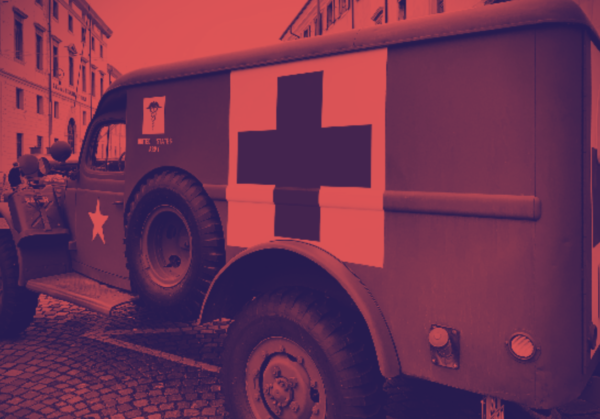
Written by Christos Tsagkaris1, Marko Dorosh2, Tayisiya Krasnova3, Anastasiia Shkodina4
[1] European Student Think Tank, Public Health and Policy Working Group, 1058 Amsterdam, The Netherlands. publichealth@esthinktank.com
[2] University of Groningen, Faculty of Theology and Religious studies, m.dorosh@student.rug.nl.
[3] Intern Physician, Kiev, Ukraine
[4] Poltava State Medical University, Poltava, Ukraine
On the 24th of February 2022, the armed forces of the Russian Federation launched an offensive against Ukraine. Within less than 24 hours, the Russian forces unleashed missiles and deployed troops against military facilities, critical infrastructure and large urban centres all over Ukraine. Early reports from both sides suggest that at least nine hundred forty soldiers and an unknown number of civilians of all ages have lost their lives, and critical infrastructure including airports, dams, telecommunication and governance premises have been destroyed.
The European Union (EU) has condemned the invasion and imposed financial and diplomatic sanctions on the Russian Federation so far. European leaders have also called upon Russia to cease fire. While further action from the EU side depends on the development of the hostility, it is necessary to stress that the armed conflict in Ukraine has severe health implications, which are very likely to affect EU member states (Donahue, 2022).
Physical and mental injury to soldiers and civilians
Ballistic missiles, air raids and hostilities on the ground can result in multiple types of injury. These include burns, bone fractures, shrapnel wounds, brain and spinal cord injuries, limb loss, blinding and loss of hearing leading to permanent disability. Up to 34% of those who survive the events may develop post-traumatic stress disorder (PTSD), a mental health condition accelerating the progression of other neuropsychiatric or physical conditions, such as dementia, depression and cardiovascular disease (Xue et al. 2015). The latest reports have highlighted the case of a woman who suffered severe health trauma and a child that lost its life during a bombardment of a residential building.
Damage to healthcare facilities
Footage combined with reports posted on social media suggest that a hospital in the city of Vuhledar received fire, leading to the death of at least three healthcare workers and patients (LB.ua, 2022). Accidental or intentional damage to healthcare facilities and casualties among the country’s healthcare workforce compromise the capacity of Ukraine’s healthcare system. This affects both the victims of the war and patients suffering from acute and chronic medical conditions including COVID-19. It constitutes a human rights violation and poses severe threat to the survival of the victims of the conflict and those who suffer from non – conflict related health conditions. Damage to healthcare infrastructure will pose significant obstacles to the recovery of the country from the crisis once the conflict is over and will deprive patients with chronic conditions of essential care in the future. It will also discourage foreign organizations providing healthcare services in the country from operating there in the future.
Destruction of critical infrastructure
Reports and footage on social media have showcased the destruction of a dam in the Pecheneg Reservoir. Residences in the vicinity were flooded and locals had to abandon their shelters (Kharkiv Today, 2022). The destruction of the dam can create food and water insecurity, due to the damage to local livestock, agriculture and pollution of local potable water sources with toxic materials of the demolished dam. Bad hygienic conditions in the area can lead to an increase of infectious diseases transmitted among humans and/or animals (Hatje et al. 2017).
Nuclear accidents and environmental disruption
The fierce fight ensued between Russian and Ukrainian forces near the defunct nuclear power plant of Chornobyl, which stands in the way from the Belarussian border to Kyiv, the capital of the country. Artillery fire and air attacks might have damaged the cement sarcophagus of the nuclear plant, leading to a leakage of nuclear radiation (Mohammed et al. 2022). Reports released on the 25th of February indicate a rising trend in the levels of radioactivity in the soil of the Chornobyl region (Radioactive Team UA, 2022; Swiss Info, 2022). Nuclear waste can subsequently contaminate underground water reservoirs and spread with the air within days. This puts both human communities and the physical environment at peril.
During the invasion, significant portions of fertile land and sites with ecological interest were damaged. In the course of hostilities, destruction of energy, water and electricity infrastructure can lead to chloride leakage. Heavy metals such as mercury and lead can also pollute the soil and the water in case environmentally hazardous industrial infrastructure is destroyed. At the same time, explosions of ammunition can ignite wildfires. During the previous years, such events have led to forest fires spreading over more than 20,000 hectares in the region of Luhansk (UAcrisis, 2021). In combination with the potential leakage of radioactive material, these pose a direct threat to the integrity of the local fauna and flora and subsequently human health. Threats to human health include infectious diseases, developmental anomalies and pulmonary disease such as pneumoconiosis among others (Ohtsuru et al. 2015).
The armed conflict as a health issue
These concerns indicate that the armed conflict in Ukraine is also a health issue. While the first two facets of this health crisis have local implications, the two latter pose a direct threat to health across Europe.
People who gather in bunkers or dwell into damaged residences and temporary shelters or find themselves trapped in congested highways cannot maintain good hygiene. The destruction of critical infrastructures depletes civilians of electrical power and clean water and deteriorates further the hygienic conditions. This can lead to a rise in infectious diseases such as cholera and typhus (Kouadio et al. 2012). Typhus in particular has already fuelled an antibiotic resistance crisis in other places of the world, where people contract the disease due to poor hygiene and take antibiotics without proper medical prescription and monitoring. This leads to a vicious circle where resistant infections are treated inadequately and lead to excess mortality (Qureshi et al. 2020; Ahmad et al. 2021). In war-torn Ukraine, poor hygienic conditions in combination with limited access to healthcare facilities can lead to the same result. The potential of transmission of novel zoonotic diseases (i.e. disease transmitted from animals to humans) due to poor personal and food hygiene constitutes an additional risk. Therefore, a cascade of infectious outbreaks following the conflict can challenge Europe’s epidemiological surveillance efforts and jeopardize financial and social stability in the region.
Simultaneously, in the event of a nuclear accident, both Ukraine and Europe will suffer from excess cancer morbidity and mortality. Longitudinal studies following nuclear accidents and bomb attacks across the globe have showed that lung, thyroid and hematological cancer can become quite more frequent in neighbouring countries for 10-30 years following the event. (Gilbert, 2009). Cancer currently represents a priority area for the EU4Health Programme of the European Union. Its frequency in Europe is expected to rise by up to 30% until 2050. Hence, excess cancer and nuclear radiation morbidity put at risk Europe’s beating cancer plan (Gourd, 2020; Orhan et al. 2021)
The problem becomes graver due to the ongoing COVID-19 pandemic. Large congregations with minimal or no protective measures can lead to a surge in infections. Due to the low vaccination rate in the country, the emergence of one or more novel SARS-CoV-2 constitutes a considerable risk with unpredictable implications for Ukraine, Europe and the rest of the world (Holt, 2021; Matiashova, 2021).
In the aftermath of COVID-19, a novel health crisis can have a detrimental impact on Europe and the world. Thus, the European Student Think Tank and its Working Group on Public Health and Policies call upon the EU to take action for the termination of the conflict and the restoration of the inflicted damage. At the same time, European health systems should be prepared to address the physical and mental health needs of refugees from Ukraine or Ukrainian expats, who already reside in EU member states. As young scientists and medical professionals, we cannot neglect that “Medicine has the obligation to point out social challenges, analyse their components and propose their solution” (JRA, 2006).
*Both the organization and the authors do not wish to take a political stance through the present article. They rather collate an evidence-based account of the health consequences of the conflict in Ukraine and Europe and urge the European Institutions to take action on this basis.
References
Ahmad, S., Tsagkaris, C., Aborode, A. T., Ul Haque, M. T., Khan, S. I., Khawaja, U. A., Carla Dos Santos Costa, A., Essar, M. Y., & Lucero-Prisno, D. E., 3rd (2021). A skeleton in the closet: The implications of COVID-19 on XDR strain of typhoid in Pakistan. Public health in practice (Oxford, England), 2, 100084. https://doi.org/10.1016/j.puhip.2021.100084
Donahue, P. (2022, February 24). Russia’s military invasion to Ukraine: U.S., EU Vow Swift Riposte, China Restrained on Russia. Bloomberg.com. Retrieved February 25, 2022, from https://www.bloomberg.com/news/articles/2022-02-24/u-s-eu-vow-swift-riposte-china-restrained-on-russia-reaction
Gilbert E. S. (2009). Ionising radiation and cancer risks: what have we learned from epidemiology?. International journal of radiation biology, 85(6), 467–482. https://doi.org/10.1080/09553000902883836
Gourd E. (2020). EU4Health budget cut threatens Europe’s Beating Cancer Plan. The Lancet. Oncology, 21(12), 1558. https://doi.org/10.1016/S1470-2045(20)30678-1
Hatje, V., Pedreira, R., de Rezende, C. E., Schettini, C., de Souza, G. C., Marin, D. C., & Hackspacher, P. C. (2017). The environmental impacts of one of the largest tailing dam failures worldwide. Scientific reports, 7(1), 10706. https://doi.org/10.1038/s41598-017-11143-x
Holt E. (2021). COVID-19 vaccination in Ukraine. The Lancet. Infectious diseases, 21(4), 462. https://doi.org/10.1016/S1473-3099(21)00156-0
JRA – (with acknowledgements to Siân Anis). (2006). Virchow misquoted, part‐quoted, and the real McCoy. Journal of Epidemiology and Community Health, 60(8), 671.
Kharkiv today. (2022, February 24). Українські військові підірвали дамбу Печенізького водосховища. Kharkiv today. Retrieved February 25, 2022, from https://2day.kh.ua/ua/kharkow/ukrayinski-viyskovi-pidirvaly-dambu-pechenizkoho-vodoskhovyshcha
Kouadio, I. K., Aljunid, S., Kamigaki, T., Hammad, K., & Oshitani, H. (2012). Infectious diseases following natural disasters: prevention and control measures. Expert review of anti-infective therapy, 10(1), 95–104. https://doi.org/10.1586/eri.11.155
LB.ua. (2022, February 24). Four killed as Russian projectile hits hospital in Vuhledar. LB.ua. Retrieved February 25, 2022, from https://en.lb.ua/news/2022/02/24/9195_four_killed_russian_projectile.html
Matiashova, L., Isayeva, G., Shanker, A., Tsagkaris, C., Aborode, A. T., Essar, M. Y., & Ahmad, S. (2021). COVID-19 vaccination in Ukraine: An update on the status of vaccination and the challenges at hand. Journal of medical virology, 93(9), 5252–5253. https://doi.org/10.1002/jmv.27091
Mohammed, A.; Landay, J. (2022, February 25). Explainer: Why Russia and Ukraine are fighting for Chernobyl disaster site. Reuters. Retrieved February 25, 2022, from https://www.reuters.com/world/europe/why-russia-ukraine-are-fighting-chernobyl-disaster-site-2022-02-25/?utm_campaign=trueAnthem%3A+Trending+Content&utm_medium=trueAnthem&utm_source=facebook&fbclid=IwAR0wFRcXUXeg6OgepgEVsTGJrcZrEh9onto8EEheYRm4sPZAbcG6ufXCGow
Ohtsuru, A., Tanigawa, K., Kumagai, A., Niwa, O., Takamura, N., Midorikawa, S., Nollet, K., Yamashita, S., Ohto, H., Chhem, R. K., & Clarke, M. (2015). Nuclear disasters and health: lessons learned, challenges, and proposals. Lancet (London, England), 386(9992), 489–497. https://doi.org/10.1016/S0140-6736(15)60994-1
Orhan, R., Paric, M., & Czabanowska, K. (2021). Lessons Learnt from the EU Response to NCDs: A Content Analysis on Building Resilient Post-COVID Health Systems. Healthcare (Basel, Switzerland), 9(12), 1659. https://doi.org/10.3390/healthcare9121659
Qureshi, S., Naveed, A. B., Yousafzai, M. T., Ahmad, K., Ansari, S., Lohana, H., Mukhtar, A., & Qamar, F. N. (2020). Response of extensively drug resistant Salmonella Typhi to treatment with meropenem and azithromycin, in Pakistan. PLoS neglected tropical diseases, 14(10), e0008682. https://doi.org/10.1371/journal.pntd.0008682
Radioactive Team . (2022, February 25). Радиационный фон в Украине, погода в припяти online. Экскурсии с Chernobyl Zone. Retrieved February 25, 2022, from https://www.chernobylzone.com.ua/radiation.html
Swissinfo.ch. (2022, February 25). Ukraine nuclear agency reports higher Chernobyl radiation levels due to heavy military equipment. swissinfo.ch. Retrieved February 25, 2022, from https://www.swissinfo.ch/eng/ukraine-nuclear-agency-reports-higher-chernobyl-radiation-levels-due-to-heavy-military-equipment/47379914
UA Crisis. (2021, November 8). Four environmental dangers of Russia’s aggression in Donbas. Uacrisis.org. . Retrieved February 25, 2022, from https://uacrisis.org/en/four-environmental-dangers-of-russia-s-aggression-in-donbas
Xue, C., Ge, Y., Tang, B., Liu, Y., Kang, P., Wang, M., & Zhang, L. (2015). A meta-analysis of risk factors for combat-related PTSD among military personnel and veterans. PloS one, 10(3), e0120270. https://doi.org/10.1371/journal.pone.0120270 https://pubmed.ncbi.nlm.nih.gov/33872477/

 The ’Ndrangheta’s Infiltration and Threat to European Institutions
The ’Ndrangheta’s Infiltration and Threat to European Institutions  From Paper to Practice: How Grassroots Norms Undermine Gender Rights in Pakistan
From Paper to Practice: How Grassroots Norms Undermine Gender Rights in Pakistan  Exploited Childhoods: The Role of Global Corporations in Perpetuating and Mitigating Child Labour
Exploited Childhoods: The Role of Global Corporations in Perpetuating and Mitigating Child Labour  Human Rights Challenges in Addressing SLAPPs in Media, NGOs and Journalism in the EU
Human Rights Challenges in Addressing SLAPPs in Media, NGOs and Journalism in the EU 


